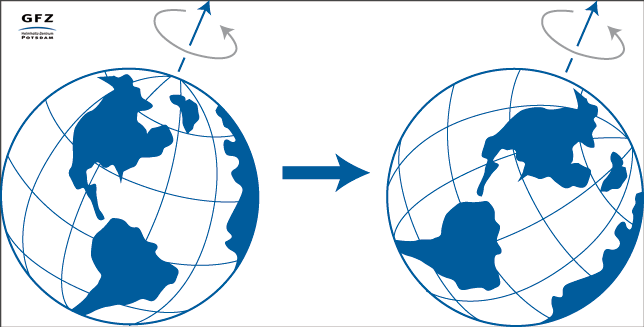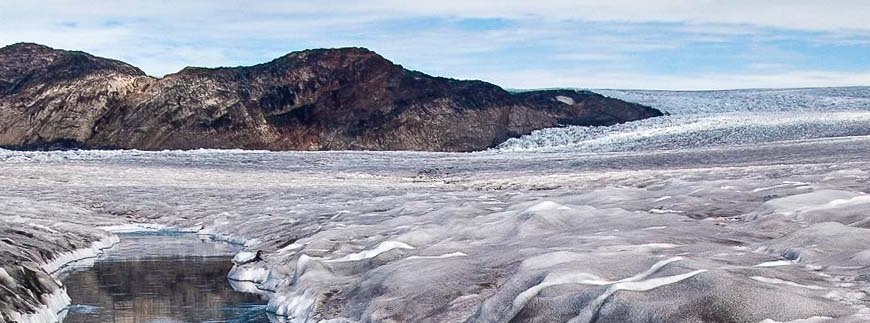The Earth turns around its axis in a non-perfect way. Since masses are irregularly distributed on the globe – mountains, oceans, or ice have an impact on the movement - , the surface of the Earth shifts in relation to the poles. Conversly, this can be described as a shift of the poles on the Earth surface. An international team of scientists led by NASA’s Jet Propulsion Laboratory with participation of Bernhard Steinberger, GFZ section Geodynamic Modelling, now show for the 20th century that the North Pole moved towards Labrador, Canada, with a speed of about 10.5 centimeters per year. At first, the scientists were, however, unable to explain the speed of this movement.
Understanding dislocations of the Earth surface in relations to the poles helps to explain changes in mass movements in and on the Earth. If the polar motion of the past is known it is for example possible to reconstruct how much land ice was “turned” into sea water which can be of use for climate models. To do so it needs to be exactly known, however, which processes drive this motion and to what extent. So far this was unclear.
At first the observations and modelling calculations of the team were still insufficient in this regard. The team was able to associate melting Greenland ice with the direction of polar motion, the speed of this movement was, however, enigmatic. In their new study published in Earth and Planetary Science Letters the scientists are able to explain this 'missing link' in their calculations:
In addition to mass changes due to melting glaciers and ice shields, rising sea level as well as the rebound of the solid Earth that follows the melting of ice shields, movements in the Earth interior were identified to be the third important factor of polar motion. Mantle convections, i.e. slow convectional movements of the solid mantle of the Earth, driven by high pressure and heat, are causing plate tectonics. These mass movements have an impact on shifts of the surface of the Earth in relation to the poles over long timescales as well: they account for about a third of these movements.
Within the team Bernhard Steinberger was in charge of calculating the share of mantle convection: “I met one of the co-authors at a conference in Japan in 2017 where he attended my talk on polar wander due to mantle convection. He told me about their problem with finding an explanation for polar motion. This was the start of our cooperation and I was able to add the ‘missing link’ into their equation”. (ak)
Original study: Adhikari, S., Caron, L., Steinberger, B., Reager, J.T., Kjeldsen, K.K., Marzeion, B., Larour, E., Ivins, E.R., 2018. What drives 20th century polar motion? Earth and Planetary Science Letters. DOI: 10.1016/j.epsl.2018.08.059









![[Translate to English:] Torsten Sachs in front of a climate station on a field](/fileadmin/_processed_/3/9/csm__TorstenSachs_bearbeitet_GS_4a1365ef84.jpeg)

![[Translate to English:] left image flood at the Ahrtal: image from above, several houses are flooded; left image:: Heidi Kreibich;](/fileadmin/_processed_/4/4/csm_Bild2_9af0130e9f.png)



![[Translate to English:] Start der Vega Rakete](/fileadmin/_processed_/6/4/csm_20231201-kachel_Vega-VV23-launch_ESA-CNES-Arianespace_706716b68c.jpeg)









![[Translate to English:] Poster exhibition at the Brandenburg Hydrogen Day at the GFZ, some participants in the foreground](/fileadmin/_processed_/6/5/csm_Erster_Brandenburgischer_Wasserstofftag_GFZ_402fcec95e.jpeg)
![[Translate to English:] Group picture of the participants](/fileadmin/_processed_/9/4/csm_20231108_CAWa-Workshop-Tashkent_Gruppenbild_99ea779d8a.jpeg)

![[Translate to English:] [Translate to English:] Hörsaal](/fileadmin/_processed_/e/6/csm_H%C3%B6rsal_e21ac645fb.jpeg)


![[Translate to English:] The Delegations in the Historic Library on the Telegrafenberg. In the back there are from left to right, the Dutch Ambassador for Germany, Ronald van Roeden, the Dutch Minister for Education, Culture and Science, Robbert Dijkgraaf and the scientific director of the GFZ, Susanne Buiter.](/fileadmin/_processed_/d/b/csm_Kachel-2_9eba4b4212.jpeg)

